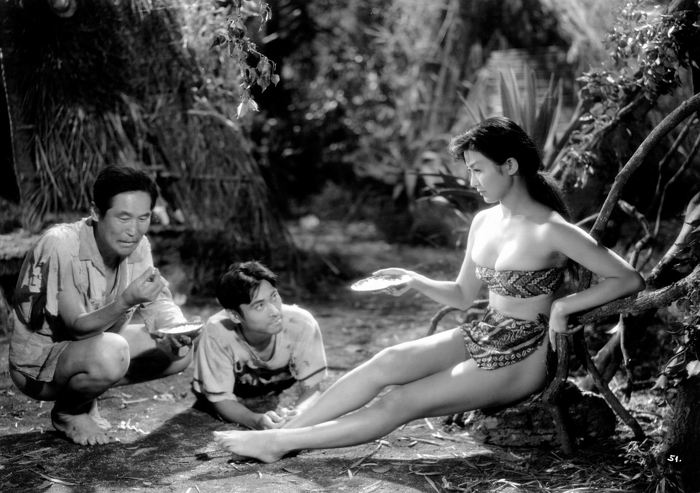 Saburo Sawai and Shigeru Amachi with 1950s sex symbol Michiko Maeda in REVENGE OF THE PEARL QUEEN, one of eight films screening at Japan Society`s `Shintoho Mind Warp` film series. Photo courtesy of Japan Society. © C.E.C.-Centro Espressioni Cinematografiche
Saburo Sawai and Shigeru Amachi with 1950s sex symbol Michiko Maeda in REVENGE OF THE PEARL QUEEN, one of eight films screening at Japan Society`s `Shintoho Mind Warp` film series. Photo courtesy of Japan Society. © C.E.C.-Centro Espressioni CinematograficheFilm Series Highlights Rare Japanese Cult Classics from Famously Rogue Studio Source: Japan Society Special Thanks to Shannon Jowett and Pauline Ceraulo `Into the Shintoho Mind Warp: Girls, Guns & Ghosts from the Second Golden Age of Japanese Film` February 27-March 10, 2013, at Japan Society, Followed by a North American Tour Born of the fires of dissidence, pioneering Japanese film studio Shintoho was founded in 1947 by employees of the Tokyo-based Toho Company during a strike (Shintoho literally means “New Toho”). The fledgling studio promptly established itself as one of the major film producers of the second golden age of Japanese cinema, specializing in low- to no-budget productions that have become absolute cult classics.
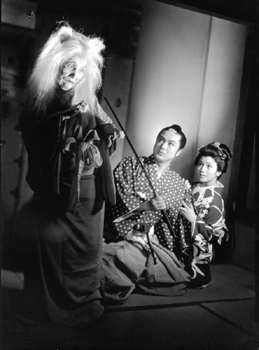 Shozaburo Date and Noriko Kitazawa face a supernatural menace in Yoshihiro Ishikawa`s directorial debut, THE GHOST CAT OF OTAMA POND. Photo courtesy of Japan Society. © C.E.C.-Centro Espressioni Cinematografiche
Shozaburo Date and Noriko Kitazawa face a supernatural menace in Yoshihiro Ishikawa`s directorial debut, THE GHOST CAT OF OTAMA POND. Photo courtesy of Japan Society. © C.E.C.-Centro Espressioni CinematograficheJapan Society’s 2013 Globus Film Series `Into the Shintoho Mind Warp: Girls, Guns & Ghosts from the Second Golden Age of Japanese Film` offers rare screenings of eight Shintoho films -- all New York Premieres and all unavailable on DVD in the U.S. -- produced from the late 1950s to the early 1960s. The series launches Wednesday, February 27 with an opening night reception featuring Japanese soul band Neo Maki Blues. All films are in Japanese with English subtitles. Often compared with Roger Corman’s exploitation-movie factory, American International Pictures, Shintoho started off in a more orthodox fashion with the holy trinity of Japanese cinema: Kenji Mizoguchi, Akira Kurosawa and Yasujiro Ozu. But it went on to revolutionize and breathe new life into Japanese genre movies, populating it with bizarre ghouls and ghosts, unruly teenagers, vampires, werewolves and curvy girls in bikinis. Shintoho produced over 500 features during a 14-year period, spanning a wide variety of genres from crime-thriller series to the youth films and exploitation films known as ero-guro (erotic grotesque). `Into the Shintoho Mind Warp` is comprised of selections from `Nudes! Guns! Ghosts!` curated by film critic Mark Schilling for the 2010 Udine Far East Film Festival, and provides a flamboyant sampling of Shintoho`s delightfully deranged output, from hard-hitting gangster movies to campy horror chillers and supernatural tales of mystery. `Into the Shintoho Mind Warp: Girls, Guns & Ghosts from the Second Golden Age of Japanese Film` runs February 27-March 10. Japan Society is located at 333 East 47th Street between First and Second avenues (accessible by the 4/5/6 and 7 subway at Grand Central or the E and M subway at Lexington Avenue). Tickets are $12/$9 Japan Society members, students and seniors. Tickets can be purchased in person at Japan Society, by calling the box office at 212-715-1258, or by visiting japansociety.org. For more information call 212-832-1155 or visit the website. After New York, the series tours North America at Philadelphia’s International House (March 28-30), San Francisco’s Yerba Buena Center for the Arts (TBD), and Vancouver’s Pacific Cinematheque (TBD). SCREENING SCHEDULE GHOST STORY OF YOTSUYA (???????, Tokaido Yotsuya Kaidan) Wednesday, February 27 at 8:00 pm Opening Night Screening Followed by a Reception
 Katsuko Wakasugi in GHOST STORY OF YOTSUYA. Photo courtesy of Japan Society. © C.E.C.-Centro Espressioni Cinematografiche
Katsuko Wakasugi in GHOST STORY OF YOTSUYA. Photo courtesy of Japan Society. © C.E.C.-Centro Espressioni Cinematografiche1959. Color, Blu-ray, 76 min., in Japanese with English subtitles. Directed by Nobuo Nakagawa. With Shigeru Amachi, Noriko Kitazawa, Katsuko Wakasugi, Shuntaro Emi, Ryuzaburo Nakamura. New York Premiere This adaption of a kabuki play by Tsuruya Nanboku (1825) is a Japanese Macbeth about a monstrous ambition whose red fruit is murder most foul. A classic of the genre and typically thought of as the best of more than 30 film adaptations, Nobuo Nakagawa`s horror masterpiece focuses on the psychology of the characters, particularly the ruthless, cruel, but humanly weak samurai and his abused wife. Nakagawa`s characteristic atmospherics are present, particularly his use of color to express the poisoning of the body (sickly greens) and mind (ghastly reds). The film however, is most memorable for the raw force of its emotions, from the shock and desolation of the betrayed wife to the fright and desperation of the doomed husband. The stand-out performance is that of Wakasugi as Iwa, whose shock and dismay as her face dissolves into a blackened, disfigured mass is indelible. THE GHOST CAT OF OTAMA POND (?? ????, Kaibyo Otama-ga-ike) Friday, March 1 at 7:00 pm
 Shozaburo Date and Noriko Kitazawa in THE GHOST CAT OF OTAMA POND. Photo courtesy of Japan Society. © C.E.C.-Centro Espressioni Cinematografiche
Shozaburo Date and Noriko Kitazawa in THE GHOST CAT OF OTAMA POND. Photo courtesy of Japan Society. © C.E.C.-Centro Espressioni Cinematografiche1960. Color, Blu-ray, 75 min., in Japanese with English subtitles. Directed by Yoshiro Ishikawa. With Shozaburo Date, Hiroshi Hayashi, Noriko Kitazawa, Namiji Matsuura, Fumiko Miyata, Torahiko Nakamura. New York Premiere In 1960, Yoshihiro Ishikawa, who had apprenticed under Shintoho harbormaster Nobuo Nakagawa, made his directorial debut with THE GHOST CAT OF OTAMA POND. The story -- a young couple caught in a web of ghostly revenge, with a black cat serving as a conduit between the worlds of the living and dead -- is familiar from the era`s horror films, though the sumptuous production, as well as the use of color, is rare for a film by a Shintoho first-timer. Nakagawa`s influence can be seen in everything from the use of otherworldly shades of red and green to the shadowy period atmospherics of the "ghost mansion," supplied by art director Haruyasu Kurosawa, a frequent Nakagawa collaborator. The film`s theatricality, from the sets to the performance styles, also echoes Nakagawa in his more Kabuki-esque moods. Ishikawa learned his lessons well -- and delivers shocks and chills that would have done his teacher proud. THE HORIZON GLITTERS (?????????, Chiheisen ga giragira) Saturday, March 2 at 3:00 pm
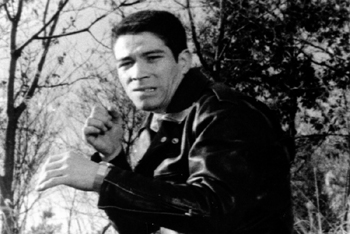 Jerry Fujio in THE HORIZON GLITTERS. Photo courtesy of Japan Society. © C.E.C.- Centro Espressioni Cinematografiche
Jerry Fujio in THE HORIZON GLITTERS. Photo courtesy of Japan Society. © C.E.C.- Centro Espressioni Cinematografiche1960. B&W, Blu-ray, 89 min., in Japanese with English subtitles. Directed by Michiyoshi Doi. With Shigeru Amachi, Masayo Banri, Toru Chiba, Jerry Fujio. New York Premiere Michiyoshi Doi`s ultra-rare black comedy (the film is not available in any format world-wide) about a prison break gone horribly wrong is unlike anything else Shintoho was making at the time. Released just before the studio`s collapse, THE HORIZON GLITTERS is a brilliant one-off made with freedom and energy that verges on the anarchic and echoes the Hollywood movies that influenced Doi`s generation of directors. Five convicts end up in the same cell: Ota a.k.a. "Capone" (Jun Tatara), Matsuda a.k.a. "Professor" (Shigeru Amachi), Tsuchiya a.k.a. "Bartender" (Ryuji Oki), Ohira a.k.a. "Irokichi" (Saburo Otsuji) and a drug smuggling sailor known as "Sea Monster" (Harumi Yuzo). With the surly Capone as boss, they maintain a rough harmony -- until a new prisoner (Fujio) is tossed into their midst. When `Mite -- short for "Dynamite" -- announces that he knows the whereabouts of a large cache of diamonds, escape is in order. Who will meet their fate before they reach the diamonds? What lies at the journey`s end? The glitter draws our heroes on -- but the horizon keeps receding. VAMPIRE BRIDE (?????, Hanayome Kyuketsuma) Saturday, March 2 at 5:15 pm
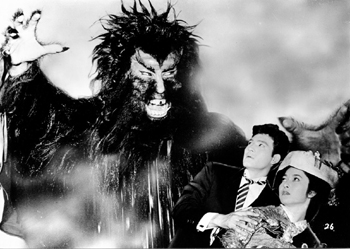 Junko Ikeuchi, Tatsuo Terashima and Yasuko Mita in VAMPIRE BRIDE. Photo courtesy of Japan Society. © C.E.C.-Centro Espressioni Cinematografiche
Junko Ikeuchi, Tatsuo Terashima and Yasuko Mita in VAMPIRE BRIDE. Photo courtesy of Japan Society. © C.E.C.-Centro Espressioni Cinematografiche1960. B&W, Blu-ray, 80 min., in Japanese with English subtitles. Directed by Kyotaro Namiki. With Junko Ikeuchi, Hiroko Amakusa, Yasuko Mita, Keiji Takamiya New York Premiere Junko Ikeuchi, who rose to stardom at Shintoho for her pure, fresh-scrubbed image, was cast in Kyotaro Namiki`s horror pic VAMPIRE BRIDE as a sort of punishment by studio boss Mitsugu Okura. She had married against his wishes -- and had to suffer the consequences when the marriage failed and she returned to Shintoho. Fujiko, a dance student with a horrific facial scar, seeks help from a sorceress in the mountains, who ultimately transforms her into a powerful monster. After undergoing a ritual that results in her temporary death, she returns to life as a fanged, hairy monster. Not long afterwards, her dance school classmates Kiyoko, a film star, and Eiko, a model, encounter Sayoko, a girl who is the spitting image of the presumed-dead Fujiko. Sayoko, it soon becomes apparent, is not a double, but the original in a new guise. But as much as Sayoko wants to live a normal, peaceful life, she cannot control the monster within her who wants payback against her tormentors. FLESH PIER (????, Jotai Sanbashi) Saturday, March 2 at 7:30 pm
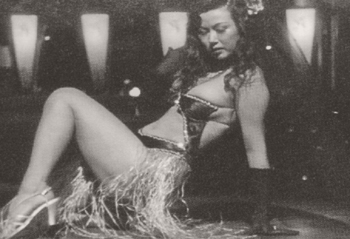 Yoko Mihara in FLESH PIER. Photo courtesy of Japan Society. © C.E.C.-Centro Espressioni Cinematografiche
Yoko Mihara in FLESH PIER. Photo courtesy of Japan Society. © C.E.C.-Centro Espressioni Cinematografiche1958. B&W, Blu-ray,75 min., in Japanese with English subtitles. Directed by Teruo Ishii. With Yoko Mihara, Ken Utsui, Akemi Tsukushi, Teruo Hata. New York Premiere Another world of illicit pleasures lies beneath the glittering neon surface of Tokyo. Ken Utsui stars as an undercover cop investigating a call-girl ring operating out of a Ginza nightclub, where he is surprised to discover the boss`s moll is his long lost love. He also recognizes a fashion model at the club -- Haruko (Akemi Tsukushi), whom he knew as a reporter when he was fighting crime in Kobe. The sharp-eyed pianist, Teruo (Teruo Hata) senses something fishy about these two -- and relays his suspicions to Rumi, who has Haruko confined in Teruo`s room. Ishii filmed his twisty story of evasions and betrayals, set in Japan`s sex industry, in the back streets of Akasaka, Ginza and Shinjuku, in a semi-documentary style with an unblinking recognition of its sordidness, together with a winking acknowledgment of its pleasures. This double-jointed approach became his trademark. DEATH ROW WOMAN (???????, Onna Shikeishu no Datsugoku) Sunday, March 3 at 5:00 pm
 Katsuko Wakasugi and Miyuki Takakura (center, L to R) in DEATH ROW WOMAN. Photo courtesy of Japan Society. © C.E.C.-Centro Espressioni Cinematografiche
Katsuko Wakasugi and Miyuki Takakura (center, L to R) in DEATH ROW WOMAN. Photo courtesy of Japan Society. © C.E.C.-Centro Espressioni Cinematografiche1960. B&W, Blu-ray, 78 min., in Japanese with English subtitles. Directed by Nobuo Nakagawa. With Miyuki Takakura, Hiroshi Hayashi, Fumiko Miyata, Yasuko Mita, Keinosuke Wada. New York Premiere Arrested for the murder of her wealthy businessman father, convicted on false evidence and sentenced to death, Kyoko, the heroine of DEATH ROW WOMAN, is determined to prove her innocence. With the aid of an older convict, she makes a daring escape and reunites with her fiancé. But with the police closing in, can they unmask the real killer in time? There is also a feminist subtext -- Kyoko not only objects to her father`s choice of husband, but also decides to have her lover`s baby minus a marriage certificate. All in all, the film is closer in sensibility to the era`s "woman`s pictures," whose typical themes were female suffering and sacrifice, than the women-in-prison exploitation pics of the 1970s. At the same time, DEATH ROW WOMAN provided the template for several of their frequent tropes, from its woman-on-woman brawls to its (mild by later standards) depictions of same-sex desire. REVENGE OF THE PEARL QUEEN (???????, Onna Shinju-o no Fukushu) Sunday, March 3 at 7:00 pm
 Michiko Maeda in REVENGE OF THE PEARL QUEEN. Photo ourtesy of Japan Society. © C.E.C.-Centro Espressioni Cinematografiche
Michiko Maeda in REVENGE OF THE PEARL QUEEN. Photo ourtesy of Japan Society. © C.E.C.-Centro Espressioni Cinematografiche1956. B&W, Blu-ray, 90 min., in Japanese with English subtitles. Directed by Toshio Shimura. With Michiko Maeda, Ken Utsui, Shigeru Amachi, Saburo Sawai, Susumu Fujita, Tetsuro Tanba. New York Premiere When Shintoho`s voluptuous new discovery Michiko Maeda undressed for REVENGE OF THE PEARL QUEEN, offering the first nude scene ever in Japanese cinema history, she hit the screens with a seismic force, and a new star was born. The film`s central plot is based on the true story of 19 Japanese men discovered on Anatahan, a tiny island in the Marianas Group, in 1951. Shimura`s version begins with a young trading company employee, Kizaki, delivering documents to the company president in Hakone. That night the president is killed and the company safe is robbed. The next day, Kizaki sees his girlfriend, Natsuki (Maeda), and the company managing director, Asanuma (Susumu Fujita), off on a voyage to the U.S., and she ends up falling overboard to escape a would-be rapist. When we next see her, she is on a tropical beach, prostrate with exhaustion, being revived by five male castaways. Diving off the coast, Natsuki discovers enough pearls to make her fortune. YELLOW LINE (???? ???????, Osen chitai-Yellow Line) Sunday, March 10 at 4:00 pm Closing Film
 Katsuko Wakasugi, Shigeru Amachi and Reiko Seto in YELLOW LINE. Photo courtesy of Japan Society. © C.E.C.-Centro Espressioni Cinematografiche
Katsuko Wakasugi, Shigeru Amachi and Reiko Seto in YELLOW LINE. Photo courtesy of Japan Society. © C.E.C.-Centro Espressioni CinematograficheJapan. 1960. B&W, Blu-ray, 79 min. In Japanese with English subtitles. Directed by Teruo Ishii. With Teruo Yoshida, Yoko Mihara, Teruko Amano, Mako Sanjo. New York Premiere A hitman (Shigeru Amachi) is betrayed by his employer. At Tokyo Station he grabs Emi (Yoko Mihara), a dancer on her way to a new job, to serve as a hostage/cover and hops a train to Kobe. Soon afterward her reporter boyfriend Mayama (Teruo Yoshida) finds Emi`s shoe and suspects that she may have walked into a trap set by a Kobe-based prostitution ring. Once in Kobe, Emi scrawls a cry for help in a ¥100 note and slips it to a shoe store employee -- but no one notices it until a young office worker, Yumiko (Mako Sanjo), happens to get it in her change. But then Yumiko is kidnapped. The intrepid Mayama soon gathers clues that lead him to the dangerous denizens of the Casbah, the dark sector of Kobe. In this film, more than any in his Shintoho period, Ishii was able to create his own special atmosphere, somewhere on the borderland between dream and reality, where the forbidden and unlawful thrill and threaten in equal measure. CURATOR Author and critic Mark Schilling has lived in Tokyo since 1975. He began reviewing Japanese films for The Japan Times in 1989 and is currently the Japan correspondent for Variety. A program advisor to the Udine Far East Film Festival in Udine, Italy since 2001, Schilling curated a retrospective of Nikkatsu Action films for the 2005 festival that was the first of its kind in the West.
About Japan Society
Founded in 1907, Japan Society is a world-class, multidisciplinary hub for global leaders, artists, scholars, educators, and English and Japanese-speaking audiences. At the Society, more than 100 events each year feature sophisticated, topically relevant presentations of Japanese art and culture and open, critical dialogue on issues of vital importance to the U.S., Japan and East Asia. An American nonprofit, nonpolitical organization, the Society cultivates a constructive, resonant and dynamic relationship between the people of the U.S. and Japan. The Japan Society Film Program offers a diverse selection of Japanese films, from classics to contemporary independent productions. Its aim is to entertain, educate and support activities in the Society`s arts & culture programs. The Film Program has included retrospectives of great directors, thematic series and many U.S. premieres. Some original film series curated by the Japan Society have traveled to other U.S. venues in tours organized by the Film Program. For more, visit japansociety.org/film.

